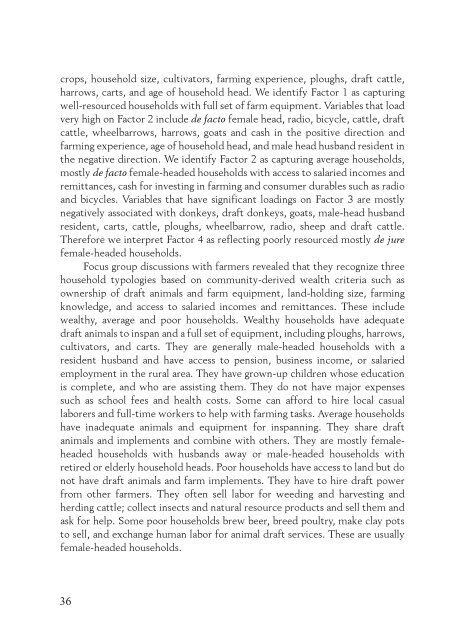Integrated Soil Water and Nutrient Management and Dry ... - Icrisat
Integrated Soil Water and Nutrient Management and Dry ... - Icrisat
Integrated Soil Water and Nutrient Management and Dry ... - Icrisat
You also want an ePaper? Increase the reach of your titles
YUMPU automatically turns print PDFs into web optimized ePapers that Google loves.
crops, household size, cultivators, farming experience, ploughs, draft cattle,<br />
harrows, carts, <strong>and</strong> age of household head. We identify Factor 1 as capturing<br />
well-resourced households with full set of farm equipment. Variables that load<br />
very high on Factor 2 include de facto female head, radio, bicycle, cattle, draft<br />
cattle, wheelbarrows, harrows, goats <strong>and</strong> cash in the positive direction <strong>and</strong><br />
farming experience, age of household head, <strong>and</strong> male head husb<strong>and</strong> resident in<br />
the negative direction. We identify Factor 2 as capturing average households,<br />
mostly de facto female-headed households with access to salaried incomes <strong>and</strong><br />
remittances, cash for investing in farming <strong>and</strong> consumer durables such as radio<br />
<strong>and</strong> bicycles. Variables that have significant loadings on Factor 3 are mostly<br />
negatively associated with donkeys, draft donkeys, goats, male-head husb<strong>and</strong><br />
resident, carts, cattle, ploughs, wheelbarrow, radio, sheep <strong>and</strong> draft cattle.<br />
Therefore we interpret Factor 4 as reflecting poorly resourced mostly de jure<br />
female-headed households.<br />
Focus group discussions with farmers revealed that they recognize three<br />
household typologies based on community-derived wealth criteria such as<br />
ownership of draft animals <strong>and</strong> farm equipment, l<strong>and</strong>-holding size, farming<br />
knowledge, <strong>and</strong> access to salaried incomes <strong>and</strong> remittances. These include<br />
wealthy, average <strong>and</strong> poor households. Wealthy households have adequate<br />
draft animals to inspan <strong>and</strong> a full set of equipment, including ploughs, harrows,<br />
cultivators, <strong>and</strong> carts. They are generally male-headed households with a<br />
resident husb<strong>and</strong> <strong>and</strong> have access to pension, business income, or salaried<br />
employment in the rural area. They have grown-up children whose education<br />
is complete, <strong>and</strong> who are assisting them. They do not have major expenses<br />
such as school fees <strong>and</strong> health costs. Some can afford to hire local casual<br />
laborers <strong>and</strong> full-time workers to help with farming tasks. Average households<br />
have inadequate animals <strong>and</strong> equipment for inspanning. They share draft<br />
animals <strong>and</strong> implements <strong>and</strong> combine with others. They are mostly femaleheaded<br />
households with husb<strong>and</strong>s away or male-headed households with<br />
retired or elderly household heads. Poor households have access to l<strong>and</strong> but do<br />
not have draft animals <strong>and</strong> farm implements. They have to hire draft power<br />
from other farmers. They often sell labor for weeding <strong>and</strong> harvesting <strong>and</strong><br />
herding cattle; collect insects <strong>and</strong> natural resource products <strong>and</strong> sell them <strong>and</strong><br />
ask for help. Some poor households brew beer, breed poultry, make clay pots<br />
to sell, <strong>and</strong> exchange human labor for animal draft services. These are usually<br />
female-headed households.<br />
36

















